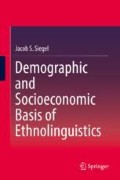Abstract
In this chapter I examine another special group of language communities. They are characterized by a technological culture that is wholly or largely premodern. They vary widely in time and place and their degree of modernity. A few of these groups have writing systems, but most do not, even though they currently may exist as viable communities amidst established national populations. Some are prehistoric, extinct-language communities. While all the communities considered here have premodern cultures, some have survived to present times as indigenous societies but in a different form than during their earlier past. Among the surviving groups, some are indigenous peoples who have been militarily overwhelmed by a colonial power, and have been so isolated that they have maintained much, if not all, of their traditional cultures in spite of the developments in the surrounding world.
Access this chapter
Tax calculation will be finalised at checkout
Purchases are for personal use only
Notes
- 1.
In preparing this section, the author relied greatly on the paper by Catherine M. Cameron, “How people moved among ancient societies: Broadening the view.” American Anthropologist 2013, 115(2):218–231.
References and Suggested Readings
Acsádi, G., & Nemeskéri, J. (1970). The history of human life span and mortality. Budapest: Akadémiai Kiádo.
Bellwood, P. (2013). First migrants: Ancient migration in global perspective. Malden: Wiley-Blackwell Publishing.
Bouchaerkt, R., Lemey, P., Dunn, M., Greenhill, S. J., et al. (2011). Mapping the origins and expansion of the indo-European language family. Science, 337(6097), 957–960.
Cabana, G. S., & Clark, J. J. (2011). Rethinking anthropological perspectives on migration. Gainesville: University Press of Florida.
Cameron, C. M. (2013). How people moved among ancient societies: Broadening the view. American Anthropologist, 115(2), 218–231.
Díaz-Polanco, H. (1998). Cambios en la consideración de la populación indígena y su autonomía. Demos, 34–35.
Faudree, P. (2013). Singing for the dead: The politics of indigenous revival in Mexico. Durham: Duke University Press.
Finkel, M. (2013, June). First Australians. National Geographic, 223(6), 60–83.
Güldemann, T., & Stoneking, M. (2008, October). A historical appraisal of clicks: A linguistic and genetic population perspective. Annual Review of Anthropology, 37, 93(109).
Gutiérrez Nájera, L. (2014). Beyond national origins: Latin@ American indigenous migration. American Anthropologist, 116(1), 153–154.
Hackenbeck, S. (2014). Book review of Peter Bellwood, first migrants: Ancient migration in global perspective. American Anthropologist, 116(2), 437–438.
Harkness, N. (2013). Songs of Seoul: An ethnography of voice and voicing in Christian South Korea. Berkeley: University of California Press.
Hill, J. B., Clark, J. J., Doelle, W. H., & Lyons, P. D. (2004). Prehistoric demography in the southwest: Migration, coalescence, and Hobokam population decline. American Antiquity, 69(4), 689–716.
Holmes, R. (2013, September 2). How many uncontacted tribes are left in the world? Washington Post, 219(2932), 6.
Hornborg, A. (2014). Political economy, ethnogenesis, and language dispersals in the prehistoric Andes: A world system perspective. American Anthropologist, 116(4), 810–823.
Humes, K. R., Jones, N. A., Ramirez, R. R./ U.S. Census Bureau. (2011). Overview of race and Hispanic origin. 2010 Census Briefs. Washington, DC: U.S. Census Bureau. (C2010BR-02).
Knight, A., Underhill, P. A., Mortensen, H. M., Zhivotovsky, L. A., et al. (2003, March 18). African Y chromosome and mtDNA divergence provides insight into the history of the click languages. Current Biology, 13, 464–473.
Ladefoged P. (1999). Decline in the world’s languages. Living on earth, February 12, 1999, interview by L. Knoy for PRI, Environmental News Magazine.
Laverchery, H. (1936). Easter Island, Polynesia. Antiquity 10(37), March. Republished in the Annual Report of the Smithsonian Institution, 1936, pp. 391–396.
Muehlmann, S. (2013). Where the river ends: Contested indigeneity in the Mexico Colorado Delta. Durham: Duke University Press.
Ortman, S. G., & Cameron, C. M. (2011). A framework for controlled comparisons of ancient southwestern movement. In M. Nelson & C. Strawhacker (Eds.), Movement, connectivity, and landscape change in the ancient southwest (pp. 233–252). Boulder: University Press of Colorado.
Pennizi, E. (2004, February 27). “The first language?” The evolution of language. Science, 303, 1319–1320.
Renfrew, C. (1987). Archeology and language: The puzzle of indo-European origins. London: Jonathan Cape.
Sanjuk, R. (2003). Rethinking migration: Ancient to future. Global Networks, 3, 315–336.
Séguy, I., Buchet, L., contributions from Caussinus, H., & Courgeau, D. (2013). Handbook of paleodemography, INED Population Studies 2. New York: Springer International Publishing.
Statistics Canada. (2006). Census of Canada, 2006. Ottawa: Statistics Canada.
Vaillant, G.C. (1937). History and stratigraphy in the valley of Mexico. Scientific Monthly 44 (April). Published originally in the Annual Report of the Smithsonian Institution, 1936, pp. 521–530.
Villagran, L. (2013). A ‘like’ for linguistics: Can social media save Mexico’s unwritten languages? Christian Science Monitor, April 1, 2013.
Webb, R. E., & Rindos, D. J. (1997). Mode and tempo of the initial colonization of empty landmasses: Sahul and the Americas compared. Archaeological Papers of the American Anthropological Association, 7, 233–250.
Author information
Authors and Affiliations
Rights and permissions
Copyright information
© 2018 Springer International Publishing AG
About this chapter
Cite this chapter
Siegel, J.S. (2018). Some Sociolinguistic Characteritics of Premodern Societies and Modern Indigenous Societies. In: Demographic and Socioeconomic Basis of Ethnolinguistics. Springer, Cham. https://doi.org/10.1007/978-3-319-61778-7_15
Download citation
DOI: https://doi.org/10.1007/978-3-319-61778-7_15
Published:
Publisher Name: Springer, Cham
Print ISBN: 978-3-319-61776-3
Online ISBN: 978-3-319-61778-7
eBook Packages: Social SciencesSocial Sciences (R0)

